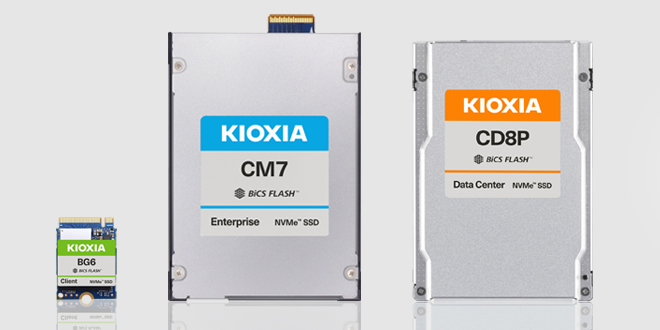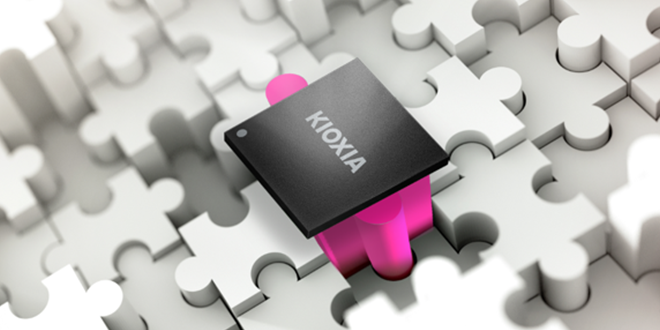Please select your location and preferred language where available.
Case Study: Edge Computing
From the Data Center to Space
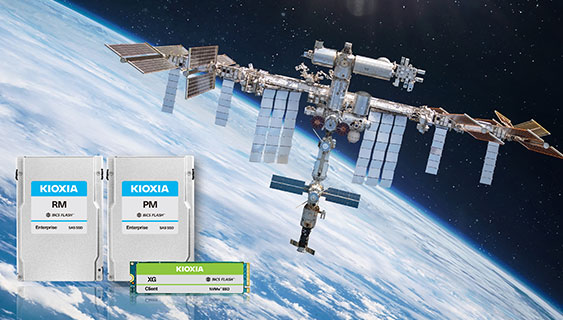
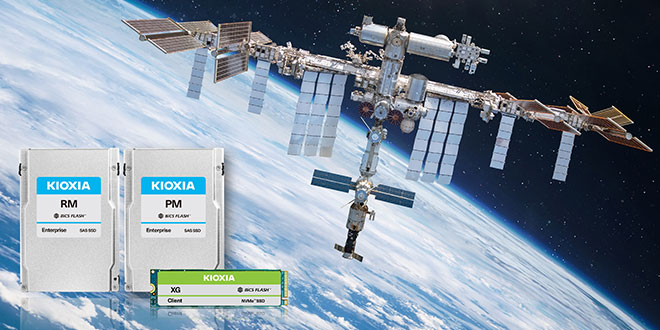
March 13, 2024
Edge Computing Case Study in 3 Minutes!
KIOXIA SSDs in HPE Spaceborne Computer-2 – KIOXIA Memory Maker (3:07)
Recently, space exploration, including satellite launches, have been regularly covered by the media worldwide. Although it was national government agencies who led the way in the past, it is now attracting attention as a new growth industry where space exploration by private companies has been increasing.
Growing Use of Edge Computing in Space
Space Computing Challenges
Business use cases in space, such as earth observation using remote sensing and analysis, have been introduced in various places. Computing on Earth is straightforward and easy, but computing in space presents new challenges, where environmental conditions are very different. There is no cloud in space, since there isn’t the technology to build a high-speed network between satellites and the cloud, both from a technical and cost standpoint, not to mention the vast amount of power needed to run the servers and processors.

Conventional Computing
As a space laboratory orbiting 254miles (appropximately 408km) above the Earth, the International Space Station (ISS) can transmit data to Earth in real time, and may take a long time if the volume of data is large. Additionally, it would cause further lag to communicate over a longer distance, such as when a spacecraft travels to Mars. This is why it is necessary to analyze data in space and send just the results, rather than send data all the way to Earth for analysis. In the past, data from various sensors in space (temperature, gas, topographic information, etc.) and high-resolution images were sent to Earth taking more than 10 hours to transmit, analyze and to ultimately produce results. With "storage" (storage media) improvements, including high capacity, small size, and higher read and write performance, it becomes possible to store data and run applications in space. This produces results in seconds or minutes, and completed analysis can be transmitted to Earth in a much shorter time.
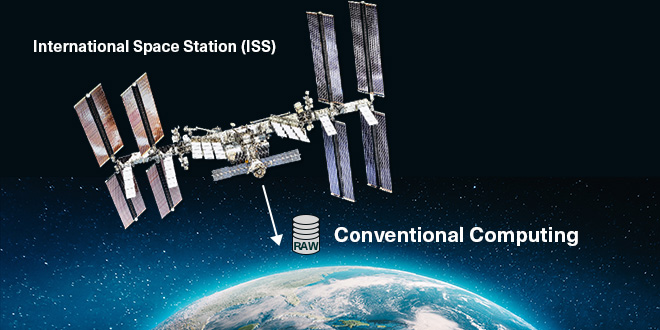
Edge Computing
This could be called the ultimate use case for "edge computing“. In cloud computing, all the required information is aggregated, and data processing is performed on high-performance servers, all in the cloud. In edge computing, data processing and analysis is performed on servers located in IoT devices and peripheral areas at the end of the network, and only the results are sent to the cloud. This can reduce unnecessary communication, delays, and network load. Edge computing plays an important role in the area of space research and exploration.
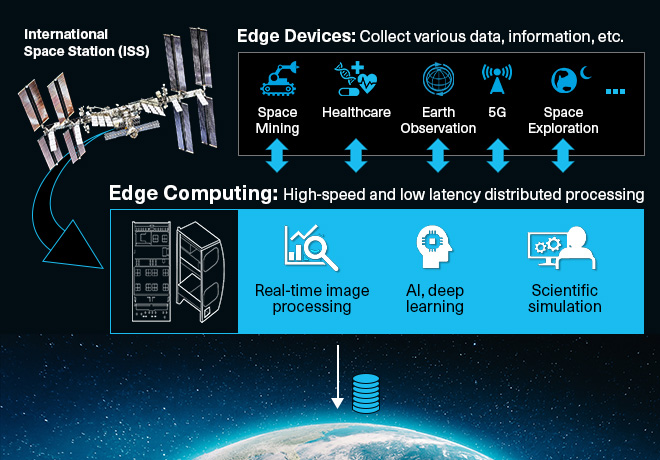
KIOXIA Approach
Spaceborne-2 Computer (SBC-2) Program
KIOXIA is participating in the Spaceborne Computer-2 (SBC-2) program with Hewlett Packard Enterprise (HPE), built with commercial off-the-shelf technology. The SBC-2 brings the first commercial edge computing and AI-enabled system to the ISS for in-space exploration, and to conduct a variety of experiments in space.
The program has a major mission to significantly advance computing technology and reduce reliance on communication of data for processing on Earth. Specifically, it is designed to perform a variety of high-performance computing processes in space, including real-time image processing, deep learning, and scientific simulations, which will contribute to advances in healthcare, image processing, natural disaster recovery, 3D printing, 5G, AI, and more. Using local high-speed processing, or edge computing capabilities in the limited space of the ISS, data from various edge devices, such as satellites and cameras, is captured and processed in real time.
KIOXIA and HPE Team Up to Send SSDs into Space
KIOXIA is the official SSD storage sponsor for this HPE SBC-2 system and is providing three KIOXIA SSD product families for data storage (see below for details). None of these SSDs have been customized or developed for space applications. They are also being tested to see how they perform in space over time through daily diagnostic health checks.
SSDs have no physical moving parts, which makes for shock resistance to withstand harsh conditions in space, such as vibration during launch, weightlessness, and unexpected power outages.

KIOXIA provides four 960 gigabyte (GB) KIOXIA RM Series Value SAS SSDs, four 30.72 terabyte (TB) KIOXIA PM Series Enterprise SAS SSDs, and eight 1,024GB KIOXIA XG Series Client NVMe™ SSDs in SBC-2. The total data storage capacity is over 130TB(1), the most data storage to travel to the International Space Station on a single mission.(2) The power-efficient 30.72TB high-capacity Enterprise SAS SSD enables 130TB of storage capacity in ISS, where power supply is limited. This is made possible by the small size, thin profile, and high capacity per unit area of the SSDs designed for installation in the limited space of the SBC-2 locker. In the future, it is expected that higher storage capacity will be uses in space.
- 1TB is equivalent to 32,000 pieces of music data (calculated as 5MB for 4 minutes music data).
- As of January 31, 2024. Kioxia Corporation survey.

From 12 Hours to 2 Seconds Processing Time
KIOXIA hardware configuration used in SBC-2 as shown below; KIOXIA SSDs are installed in HPE Edgeline EL4000 and HPE ProLiant DL360 Gen10 servers (collectively referred to as “SBC-2 server”) aboard the ISS.
Data transmission to the earth with 1.8 GB data compressed to 1/10 of its original size takes approximately 12 hours. Using SBC-2 server, the application is uploaded to the SBC-2 server and run in a Docker container, which provides results in 6 minutes of hybrid CPU and GPU data processing. Data transmission that previously took more than 12 hours, now takes only about 2 seconds, which is 1/20,000 of the original 12 hours to send just 92KB of data. It is much faster to compute and analyze data by edge computing in space without sending the unprocessed raw data to earth.
Once it becomes common practice to analyze data in space, rather than sending that raw data to earth for processing, it is expected to reduce “time-to-knowledge” from months to minutes. The knowledge gains using the HPE SBC-2 project will lead to new advancements in KIOXIA SSD products. There are high expectations for storage technologies, including SSD products, that enable higher capacity and faster processing for potential future space expeditions.

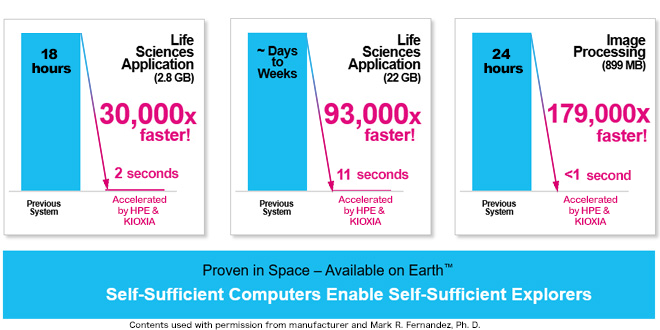
Making Memories from Spaceborne Computer-2 - The Vision for the Future of Storage
KIOXIA SSDs took flight with the launch of the NG-20 mission rocket to the ISS, delivering an updated HPE SBC-2 system, based on HPE Edgeline and ProLiant servers.
Flash memory technology and SSD products continue to evolve, making high performance and large capacity more readily available and expanding the range of applications even further. KIOXIA is also working on a unique research project called "Memory-centric AI ". This technology is being developed to contribute to faster AI learning that uses large amounts of data, and also be effective in the simulation/HPC field to gain insight from large amounts of data. Flash memory technology and SSD products are indispensable in the age of "data x AI" and "data first."
News Releases
- Definition of capacity: KIOXIA Corporation defines a megabyte (MB) as 1,000,000 bytes, a gigabyte (GB) as 1,000,000,000 bytes and a terabyte (TB) as 1,000,000,000,000 bytes. A computer operating system, however, reports storage capacity using powers of 2 for the definition of 1GB = 2^30 bytes = 1,073,741,824 bytes and 1TB = 2^40 bytes = 1,099,511,627,776 bytes and therefore shows less storage capacity. Available storage capacity (including examples of various media files) will vary based on file size, formatting, settings, software and operating system, and/or pre-installed software applications, or media content. Actual formatted capacity may vary.
- NVMe is a registered or unregistered mark of NVM Express, Inc. in the United States and other countries.
- HPE, ProLiant and Edgeline are registered trademarks of Hewlett Packard Enterprise and/or its affiliates.
- Docker and the Docker logo are trademarks or registered trademarks of Docker, Inc. in the United States and/or other countries. Docker, Inc. and other parties may also have trademark rights in other terms used herein.
- Product image may represent a design model.
- Other company names, product names, and service names may be trademarks of third-party companies.
